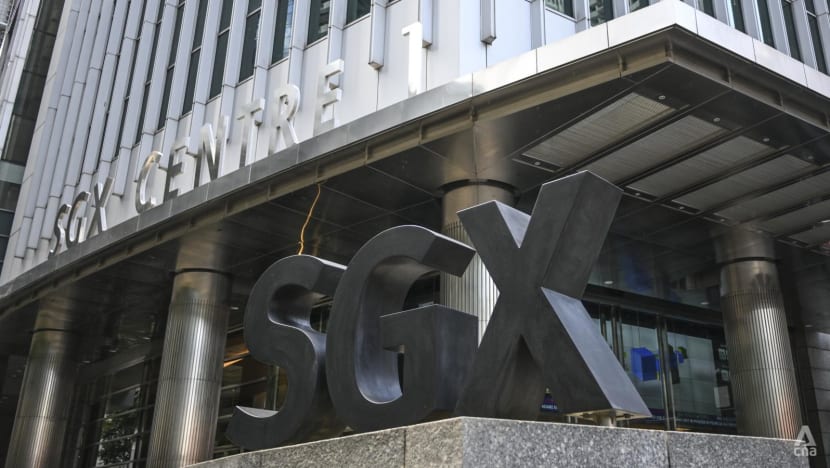Commentary: Singapore's S$5 billion bet on the stock market
Singapore is pumping in S$5 billion to boost the equity market in a bid to increase investor interest and attract new listings. While a positive start, more innovative thinking will be necessary to fully unlock SGX’s potential, says financial journalist Ven Sreenivasan.

The exterior of the Singapore Exchange building on Jan 6, 2025. (Photo:CNA/Wallace Woon)

This audio is generated by an AI tool.
SINGAPORE: Just as global markets face fresh uncertainty from United States President Donald Trump’s sweeping new global tariffs, Singapore is stepping up its game, working to revitalise its stock market and present itself as a trusted hub for company listings.
The Singapore stock market faces several well-documented challenges: It suffers from low liquidity, is undervalued, and has been experiencing a wave of privatisations.
The average daily trading volume on the Singapore Exchange (SGX) is S$1.3 billion (US$973 million), on par with Kuala Lumpur but below Bangkok and Sydney. Market capitalisation of the Singapore bourse stands at around S$876 billion, compared with US$4.5 trillion for Hong Kong and Sydney's US$1.9 trillion. Not particularly impressive for one of Asia's leading financial centers.
Some 60 per cent of companies on the SGX trade below book values, with the median price-to-book (P/B) ratio at about 0.6 times. In comparison, over 90 per cent of the companies in the S&P 500 index trade above their book value, despite the recent volatility induced by political events.
Furthermore, on the local bourse there is a lack of institutional participation, high short-selling activity, and concerns among companies about the cost of staying listed.
S$5 BILLION MARKET MAKEOVER
In response to these issues, the Monetary Authority of Singapore's (MAS) Equities Market Review Group (EMRG) recently announced several measures, including a S$5 billion Equity Market Development Programme. This initiative is designed to encourage more investment in Singapore-listed equities.
It includes incentives for fund managers with a proven investment track record, as well as tax incentives for income generated through fund management and advisory services focused on Singapore-listed stocks.
The programme also offers a reduced 20 per cent corporate income tax rate for new primary listings, along with a 10 per cent tax rebate for secondary listings.
Additionally, there will be an enhanced tax rate of 5 per cent on qualifying income from funds listed in Singapore. To streamline the listing process, the EMRG has proposed reducing the time to market and offering greater flexibility for issuers to engage with investors before launching IPOs. Prospectus disclosure requirements will also be simplified, focusing on the core information that is essential for informed investment decisions.
While these steps are a positive start, their effectiveness remains a subject of debate.
The S$5 billion programme could be instrumental in attracting more funds to the local market, especially given that much of the assets under management (AUM) by Singapore-based fund managers are currently deployed outside the country. According to the MAS asset management survey of 2022, 88 per cent of the S$4.9 trillion in AUM managed by institutions in Singapore is invested abroad, primarily in the Asia-Pacific region (excluding Singapore).
The key question is how these funds will be allocated and whether they will be used to target the small- and mid-cap sectors of the market, which are largely undervalued and overlooked.
SMALL-CAP STRENGTH
The three major banks in Singapore - DBS, OCBC, and UOB - dominate the market, accounting for about 25 per cent of daily trading volume. Their strong performance has led to a significant increase in their combined weighting in the Straits Times Index (STI), from 40 per cent in 2019 to 54 per cent today.
However, over 80 per cent of the listed companies on the SGX have a market capitalisation of under US$1 billion, positioning the exchange as a small-cap market. This segment, particularly small and mid-cap stocks, remains undervalued despite being well-run, profitable, and offering attractive dividends. Revitalising this market segment could bring much-needed liquidity and energy to the SGX.
Rather than forcing fund managers to invest in individual stocks, a more effective strategy could be to create indices and exchange-traded funds (ETFs) based on small and mid-cap companies - perhaps an SGX50, SGX100, and SGX200.
These funds would make it easier for institutional investors, including family offices, to gain exposure to small- and mid-caps, thus enhancing liquidity. Such a move could significantly alter the trading dynamics of the local market by bringing institutional money into previously neglected segments.
While the EMRG's S$5 billion initiative appears to be a step in the right direction, some industry observers argue that more could be done to support the SGX. For example, it is worth considering if government-backed funds like the Government of Singapore Investment Corporation (GIC) should invest in SGX-listed stocks.
If the SGX succeeds in attracting regional companies to list here, it makes little sense if the GIC does not invest in them, particularly when it does so on other exchanges like Hong Kong. Such an approach could further increase the appeal of the SGX as a listing destination.
The issue of delisting, which has been a growing concern with about 20 companies delisting last year and five so far this year, may also be alleviated if the S$5 billion programme injects sufficient liquidity into the market. In addition, the tax incentives already announced will serve as an attractive catalyst for companies to consider the Singapore market for their IPOs.
However, there is room for further improvement. One potential area is investor education. Retail investors, particularly the younger demographic, tend to gravitate towards overseas markets and more volatile assets like cryptocurrencies. Given that the current SGX retail base is largely aged 55 and above, efforts to engage younger investors could help diversify the investor base and encourage more participation in the local market.
Analyst coverage of mid- and small-cap stocks could also be enhanced. Analysts should be encouraged to identify and promote undervalued stocks with growth potential, rather than focusing primarily on large-cap companies. Brokers, too, should be more willing to engage with clients and promote growth and value stocks, aligning with investors' risk appetites.
Lastly, attracting large, well-known companies to list on the SGX, such as PSA, Changi Airport, and NTUC, could serve as a powerful signal of the exchange's competitiveness. Waiving or reducing some transaction fees and taxes could further reduce costs and make the SGX one of the most attractive trading platforms in Asia.
TIME TO STEP UP
The uncertainty stirred up by the policies of the Trump administration has pushed investors to rethink where they put their money. There’s been a clear shift away from developed markets like Wall Street to Asia.
Singapore has long been one of the leading financial hubs in Asia, and there is no reason why its bourse cannot become a prime destination for funds and new listings.
Indeed, the STI has tested new highs in recent days, crossing the 4,000 mark for the first time on Mar 28.
While the EMRG's current steps are commendable, more innovative thinking and decisive action will be necessary to fully unlock the potential of the Singapore stock market.
Industry participants want to see a more comprehensive and bold approach. A more holistic, out-of-the-box approach could be the key to revitalising the local bourse and making it a beacon for investors.
Ven Sreenivasan is a former editor and journalist who has covered financial markets, economic and corporate news and aviation for over more than 30 years.



















